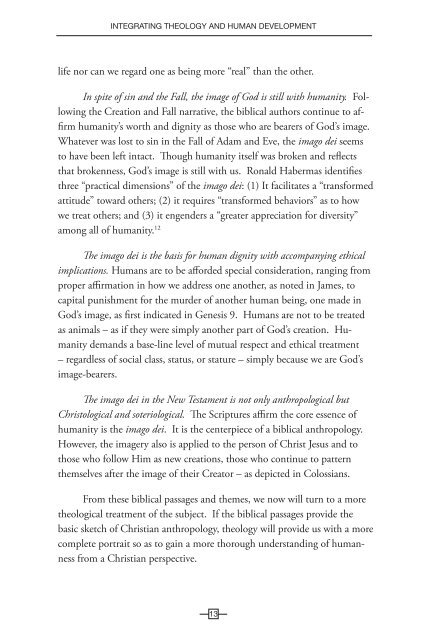Christian Formation: An Integrative Approach - B&H Publishing Group
Christian Formation: An Integrative Approach - B&H Publishing Group
Christian Formation: An Integrative Approach - B&H Publishing Group
Create successful ePaper yourself
Turn your PDF publications into a flip-book with our unique Google optimized e-Paper software.
IntegratIng theology and human development<br />
life nor can we regard one as being more “real” than the other.<br />
In spite of sin and the Fall, the image of God is still with humanity. Following<br />
the Creation and Fall narrative, the biblical authors continue to affirm<br />
humanity’s worth and dignity as those who are bearers of God’s image.<br />
Whatever was lost to sin in the Fall of Adam and Eve, the imago dei seems<br />
to have been left intact. Though humanity itself was broken and reflects<br />
that brokenness, God’s image is still with us. Ronald Habermas identifies<br />
three “practical dimensions” of the imago dei: (1) It facilitates a “transformed<br />
attitude” toward others; (2) it requires “transformed behaviors” as to how<br />
we treat others; and (3) it engenders a “greater appreciation for diversity”<br />
among all of humanity. 12<br />
The imago dei is the basis for human dignity with accompanying ethical<br />
implications. Humans are to be afforded special consideration, ranging from<br />
proper affirmation in how we address one another, as noted in James, to<br />
capital punishment for the murder of another human being, one made in<br />
God’s image, as first indicated in Genesis 9. Humans are not to be treated<br />
as animals – as if they were simply another part of God’s creation. Humanity<br />
demands a base-line level of mutual respect and ethical treatment<br />
– regardless of social class, status, or stature – simply because we are God’s<br />
image-bearers.<br />
The imago dei in the New Testament is not only anthropological but<br />
Christological and soteriological. The Scriptures affirm the core essence of<br />
humanity is the imago dei. It is the centerpiece of a biblical anthropology.<br />
However, the imagery also is applied to the person of Christ Jesus and to<br />
those who follow Him as new creations, those who continue to pattern<br />
themselves after the image of their Creator – as depicted in Colossians.<br />
From these biblical passages and themes, we now will turn to a more<br />
theological treatment of the subject. If the biblical passages provide the<br />
basic sketch of <strong>Christian</strong> anthropology, theology will provide us with a more<br />
complete portrait so as to gain a more thorough understanding of humanness<br />
from a <strong>Christian</strong> perspective.<br />
13




